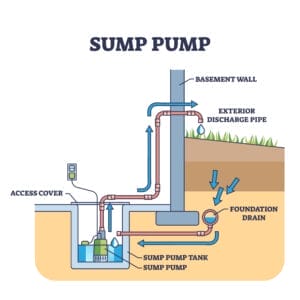What Is A Sump Pump?
A sump pump is a device that is designed to prevent flooding. They are a recommended device for any home that has a basement. Sump pumps will collect water underneath your home. When a certain amount of water is collected, it will pump it out through certain tubes or pipes, moving the excess water to a safe location of your choosing. This provides an extra layer of defence against flooding in your basement.
Why Should I Have A Sump Pump?
Any home is at risk of being flooded since water can always build up in a home's foundation over extended periods. This build-up means that your basement could get flooded even if you are fortunate enough to live in an area that never suffers from large rain storms. A sump pump system is designed to prevent this.
While you might find the cost of a sump pump slightly intimidating, the savings it can provide far exceed the price. While a sump pump will cost you hundreds, or maybe even a couple of thousand dollars, simply by preventing a single flooding incident, it can save you thousands, or even tens of thousands of dollars in out-of-pocket repairs for things like structural damage, damage to the basement itself and many of your belongings. Even if you have a great home insurance policy, contents insurance, and overland water insurance that could cover these costs entirely, your rates could significantly increase, which in the long run, will still cost you more than a sump pump. In addition to all of these costs, you would also have to deal with the hassle of getting repairs and replacing many of your belongings.
How Does A Sump Pump Work?
A sump pump is designed to prevent basement flooding. It does this by having a basin that collects water near the foundation. When the water within the basin reaches a certain level, the sump pump turns on. The sump pump turning on takes the water in the basin and moves the water through a pipe and away from the home, preventing further flooding.

A sump pump system for home basement diagram.
Does Having A Sump Pump Impact My Insurance?
It depends. Part of what makes each insurance company different is that they offer different discounts on insurance. Some insurance companies will offer you a discount on your insurance rates, while others won't. If you would like to know if your home insurance provider offers a discount for sump pump usage or have any other questions about your insurance, your Morison Insurance broker would be happy to assist.
What Is A Sump Pump Basin?
A sump pump basin often looks remarkably like an ordinary bin. However, it is designed to work with sump pumps. Although many people use a standard bucket, it is recommended that you don't do this, as sump basins are explicitly designed for their role. These basins have four things that make them much more suitable than a simple bucket. These are a sealed lid, a pump stand, erosion control, and large holes.
A sealed lid prevents general debris, gasses and other objects from entering or falling in. It also provides a layer of safety that stops pets and children from damaging anything or hurting themselves. A pump stand raises the sump pump off the ground, meaning that it won't clog up the pump itself when debris gathers at the bottom of the pit. Erosion control prevents soil from eroding under the foundation and floor. Large holes allow for the sump pump basin to fill with water quickly, leading to a faster discharge of water away from your home's basement.
Types Of Sump Pumps
Not all sump pumps are the same. There are different types of sump pumps, each with pros and cons. Although we can not tell you which one is best suited for your particular needs, we can give you a general idea of what the pros and cons are for each, allowing you to make an informed decision.
Please note that many sump pumps are a combination of different types. The two primary sump pump types are submersible and pedestal, mutually exclusive. Other secondary pumps, such as a battery backup, are also categorized as submersible or pedestal.
Submersible Sump Pump
A submersible sump pump is the most common type of sump pump. As the name suggests, it is submerged deep within the basin and rests underwater when it begins to fill up. They are recommended if you have a deep pit due to their benefits.
Submersible sump pumps have lots of advantages over other types. For example, they are generally more powerful,, allowing them to pump water faster than their competitors. Also, since they're underground, they don't occupy any space in your basement. In addition to these perks, a submersible sump pump is quieter than its competitors. When it removes water from your house's foundation, it is quieter, meaning that it won't provide as much distraction throughout the entire house. There's a strong possibility that you'll barely hear it in most rooms, if at all.
Pedestal Sump Pump
A pedestal sump pump operates differently than a submersible one. A pedestal sump pump comprises a hose that is fed into the pit and a motor that is held above ground. Since they are more compact and can fit into many pits that a submersible pump cannot, they are recommended for those with a shallower pit.
While less popular than submersible options, pedestal models do have benefits that a submersible model doesn't. For these reasons, they used to be the more popular model. In addition to the lower costs per model, pedestal pumps can last much longer due to not needing as much power, and if they need repairs, doing so is easier and cheaper. Also, some pits are so shallow that submersible pumps can't work. In those instances, a pedestal pump becomes your only option.
Battery Backup Sump Pump
A battery backup sump pump is not intended to be the primary way to remove water from your sump pump basin. You won't have to use it if you get lucky.
As you would likely guess, a backup battery sump pump is operated by a battery. Although this results in it being unable to provide nearly as much power as other forms, it is not recommended to be used as your primary pump and only recommended to be used as a backup in the event of a blackout.
Since many of the severe storms that cause basement flooding can contain lightning, high winds, hail, and similar dangers, the idea that you would need a backup pump during power outages isn't very far-fetched. Due to the risk of such a situation, it is a common recommendation to have a battery backup sump pump in addition to your primary device. It is also preferred by insurance companies so that you still have a sump pump running if the power goes out.
It should be noted, however, that the batteries on these devices often only last about 12 hours, meaning that having spare batteries is also recommended.
Combination Sump Pump
If you like the security of having a secondary device granted by a battery backup but don't want to go through the issue of having an entirely separate pump in the case of a power failure, consider a combination pump. These devices operate primarily off of your home's power system but still contain a backup battery, allowing it to continue running in the case of a power outage, similar to how when a hybrid car runs out of electricity, it can begin to use gas. Another benefit is that a combination pump can run off the home's power and its battery if the threat of flooding is prominent, although this does drain the battery.
Sewage Sump Pump
While not traditionally used for this role, a sewage pump (also known as an ejector pump) can get the job done. The traditional role of a sewage pump is to take water from basement drains and toilets and bring it to the main sewer line, allowing it to leave the property. While traditionally not suited for the role of a sump pump, they are capable of performing it. They are also better at passing solids within their system.
How Do I Maintain A Sump Pump?
While a sump pump is a great device, like any piece of machinery, it wears down over time, meaning it's important to maintain them to ensure they last as long as possible.
Firstly, you should know basic information about your sump pump. This includes what type of sump pump it is, any parts that might need to be replaced, any ongoing issues, and the approximate age of the device. It's also important to clean the device every now and then, as well as ensure any vulnerable equipment is well protected. If you notice any rust, damaged parts, or strange odours, there has probably been some damage.
Another critical step in sump pump maintenance is to test the device regularly since you want to avoid finding out in the middle of a heavy storm that your pump needs to be fixed. When testing your pump, be on the lookout for strange noises, including rattling and jamming, among many others. Has trouble starting leaking fluids, excessive vibrating or the device turning on and off more or less intermittently than is normal.
If you notice anything wrong with the device at any point and aren't sure how to fix the problem, you are advised to call a professional or replace the pump entirely. How long a sump pump will last depends on several factors, and although 7-10 years is an approximate guideline, good maintenance can extend its life. A well-cared-for sump pump can protect your basement from flooding for a long time.
This content is written by our Morison Insurance team. All information posted is merely for educational and informational purposes. It is not intended as a substitute for professional advice. Should you decide to act upon any information in this article, you do so at your own risk. While the information on this website has been verified to the best of our abilities, we cannot guarantee that there are no mistakes or errors.


